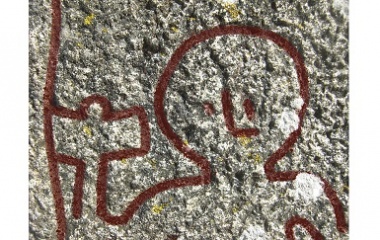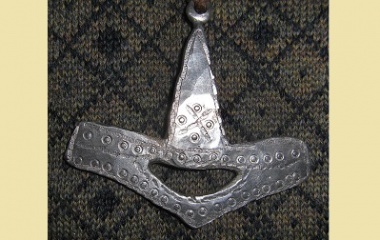Swords, clubs, scythes, bows, axes and other deadly weapons augmented the strength of the gods in ancient mythology. The Nordic god of thunder wielded a hammer with the power to preserve the order of the cosmos or cause immense destruction in one strike.
What Is Mjölnir?
Mjölnir (pronounced Miol-neer) is the name of Thor’s hammer in Nordic mythology. The hammer gave Thor his extensive power and was said to be forged by a dwarf. Due to the weapon’s short handle, Thor could only wield it with one hand and had to wear magical iron gloves in order to grip the shaft. The thunder god used the hammer to protect heaven and Earth from enemies, such as the giants and their destructive force. According to some sources, the name Mjölnir may mean lightning in Old Norse. Authors also believe the word may mean white and refer to purity, such as the purity of white lightning. When the people heard the sound of thunder, they knew Thor, whose name means thunder, and his hammer were at work!
The Hammer’s Creation
Mjölnir was created through the trickery of the god Loki also known as the trickster. Loki was up to his customary shenanigans one day, when he got on the wrong side of Thor after he cut off the golden locks of hair of Thor’s wife, Sif. Thor became infuriated and threatened to shatter his bones, but Loki managed to dodge Thor’s wrath, promising he would acquire even lovelier locks for Sif from the dwarves. Thor capitulated and let Loki go to Svartalfheim, the caves where the dwarves resided.
The dwarves were allegedly master craftsmen and thus Loki succeeded in his task, even managing to trick the dwarves into producing more treasured items. Loki accepted the wondrous new head of hair from the sons of one of the dwarves, Ivaldi. The two dwarves also created another two magnificent pieces, Skidbladnir, a ship that could fold up to fit in one’s pocket and always had the best winds in its sails, and a deadly spear called Gungnir. Loki was enamored by their masterful work and decided he wanted more! He tricked another two dwarf brothers, Brokkr and Sindri, into crafting further fine works for him. He manipulated them by saying they would not be able to craft better items than the other two brothers had. Sindri then created Gullinbursti, a boar with golden hair, even though Loki had turned into a fly and tried to put him off his task. Sindri created another piece called the Draupnir, a golden ring which reproduced itself eight times every ninth night. Next, Sindri began to work on a hammer, but Loki, who had turned into a fly again, bit him on the eyelid. He managed to still produce Mjölnir even with Loki’s interference, but the weapon ended up having a shorter handle than he wished.
The two dwarf brothers, Sindri and Brokkr, went up to Asgard to claim payment for the three magnificent pieces they’d created, but unfortunately for them, Loki arrived back first. Loki gave the hammer and new hair to Thor, the ring and spear to Odin, and the ship and the golden-haired boar he gave to Freyr. The gods acknowledged Loki needed to stick to the deal he had struck with the dwarves, which now required him to offer them his head! He had bet his head on the dwarves not achieving his challenge, yet he still managed to worm his way out of the arrangement. He reminded the dwarf brothers that his head was attached to his neck and he had not promised them his neck too! In the end, the dwarves were happy to merely sew Loki’s mouth shut!
The Hammer’s Functions
Thor’s hammer served as a ceremonial tool, as well as a weapon of war. Mjölnir was also used as an instrument of blessing in births, weddings, and possibly funerals, too. The symbol was found on many grave stones up to 1300 AD, according to sources. The powerful hammer was, however, stolen on one notable occasion. The Poetic Edda relates a story of a giant who manages to get their hands on it and, in exchange, insists on marrying the goddess Freyja for the hammer’s return. Thor dresses in Freyja’s clothes and manages to fool the giant into believing he is the goddess. When the time came for the blessing of the marriage, Thor grabbed Mjölnir and annihilated the giants.
An ancient rock carving depicts a scene of a marriage blessed with Thor’s hammer. Historians believe that couples would receive the blessing of fertility at the same time, as Thor was associated with the fertilization of crops and agriculture. The blessing would also take the couple from the realm of chaos, associated with the giants, into order, the way the Norse viewed the cosmos.
The Hammer Symbol
During the time of Christianization in Northern Europe, the symbol of Mjölnir took on additional significance. The Christian symbol most commonly seen was the cross and, in order to differentiate themselves, those that held on to the old beliefs bore the symbol of Thor’s hammer. In Nordic mythology, the Christians were aligned with the giants and chaos as they were trying to destroy their ancient culture. Those that opposed the Christians were fighting to save the cosmos, much like Thor and his mythical hammer, Mjölnir.
Modern Use
Neopagans still make use of the symbol of Thor’s hammer. To them, Mjölnir represents Thor’s vast power. Followers of Asatru, a revival of Old Nordic religion, bear the symbol to tie them to the old traditions. Marvel utilize Thor’s hammer frequently in their movies and comic books, too.
Thor’s hammer was a powerful tool of both blessing and destruction in Nordic mythology and in the present day. With Mjölnir, he was able to spurn chaos and preserve the innangard, or order, of the universe, just as many cultures today try to preserve their ancient practices and beliefs.










